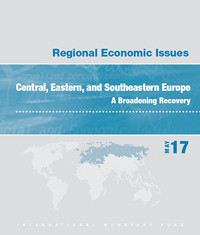EXECUTIVE SUMMARY
Growth has broadened across Central, Eastern, and Southeastern Europe (CESEE). Outside the Commonwealth of Independent States (CIS) and Turkey, growth has remained strong, driven by accommodative policies. Meanwhile, Russia and the rest of the CIS are finally on the road to recovery, with firming oil prices lifting activity. Growth in Turkey has rebounded partially after dropping sharply in the wake of elevated political uncertainty.
Inflation has started to increase in many countries. Labor markets have tightened, with unemployment rates now falling to pre-crisis levels along with strong wage growth. Output gaps appear largely closed. With commodity prices and euro area inflation higher, CESEE headline inflation has picked up. In Russia, inflation is in retreat, but it remains high in Turkey.
Near-term prospects are favorable, helped by strengthening global activity and continued supportive domestic macroeconomic policies. Outside the CIS and Turkey, growth is projected to pick up, fueled by domestic demand and greater absorption of European Union (EU) structural funds. The recovery in Russia will support activity in other CIS and Baltic countries. In Turkey, growth is expected to remain weak amid ongoing political and economic uncertainty.
Risks to the outlook are two sided, but tilted to the downside, notably over the medium term. There is potential for some upside from stronger external demand, notably higher growth in the euro area and the United States, and a firmer recovery in commodity prices, which would help the CIS, and lower political uncertainty following key elections in Western Europe. Key downside risks include a global shift toward inward-looking policies and protectionism, a sudden tightening in global financial conditions, new shocks in advanced European economies, and further wage increases that could hurt competitiveness.
In countries with largely closed output gaps, macroeconomic policy normalization needs to begin. The priority is to start reducing still relatively large cyclically adjusted fiscal deficits to achieve medium-term fiscal targets, which will help lower vulnerabilities. Furthermore, where inflation is picking up on a sustained basis, monetary policy will soon need to gradually withdraw accommodation. A tighter fiscal stance would allow monetary policy to normalize more gradually in most inflation targeters, helping maintain hard-won gains in competitiveness. Meanwhile, Turkey needs to tighten monetary policy further to lower inflation and reduce elevated external vulnerabilities. By contrast, Russia can continue with monetary policy easing as inflation declines toward the central bank’s target and fiscal policy is adjusting to lower oil prices.
The main medium-term policy challenge is to boost potential growth and income convergence with structural reforms. Gains from past reforms are largely exhausted and speeding up convergence is now more challenging. This would require strengthening institutions; improving public sector efficiency, including through restructuring state-owned enterprises and enhancing public sector investment management frameworks; and improving labor supply by raising participation rates and reducing structural unemployment.



